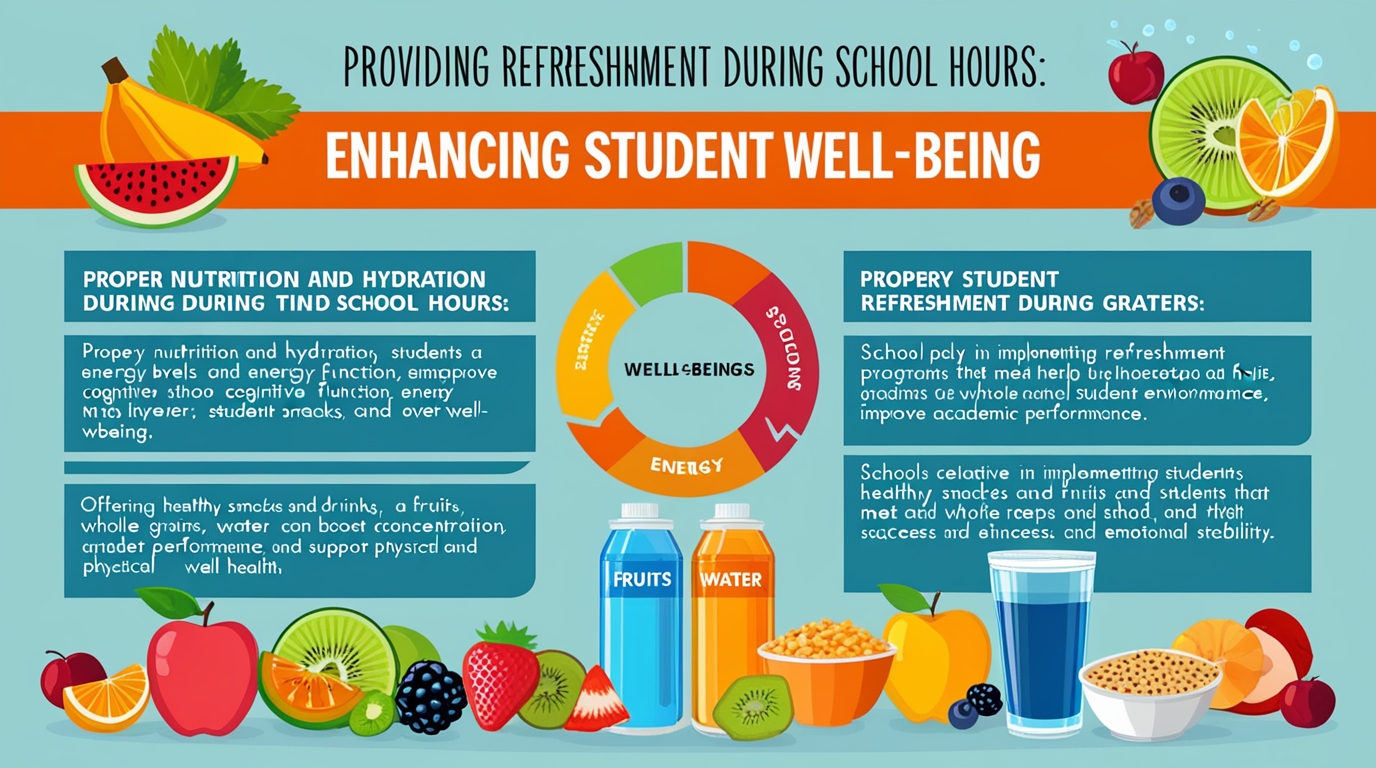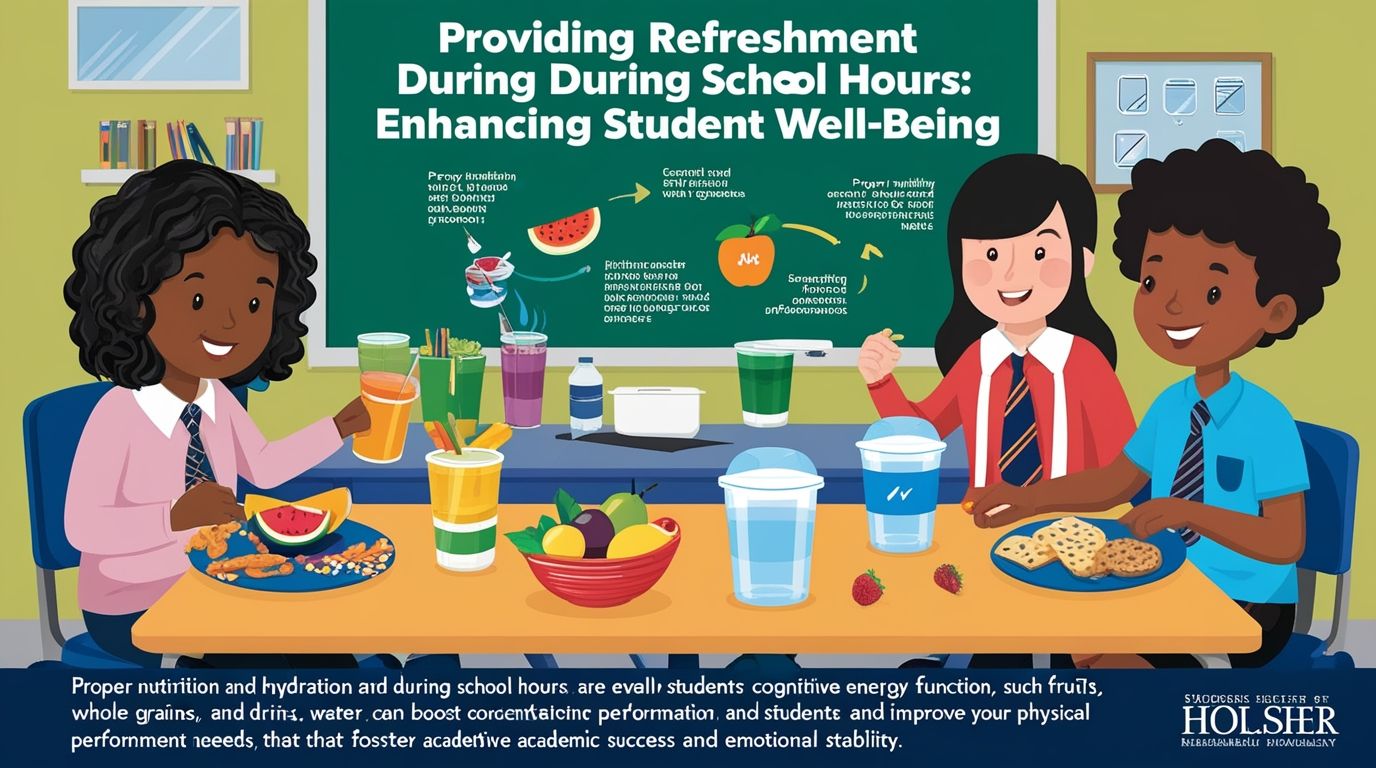Introduction
Providing Refreshment During School Hours in the modern educational environment, the well-being of students is closely linked to their academic performance. Among the various factors contributing to student success, proper nutrition and hydration during school hours stand out as crucial elements. Providing refreshment during school hours is not just about satisfying hunger or quenching thirst; it plays a vital role in enhancing cognitive function, maintaining energy levels, and fostering a positive learning environment. This article explores the significance of providing refreshment during school hours, the types of refreshments that are beneficial, and how schools can effectively implement these practices.
The Importance of Refreshment in Schools
Cognitive Function and Academic Performance
Nutrition and hydration have a direct impact on cognitive function, which in turn influences academic performance. Studies have shown that students who well-nourished and adequately hydrated tend to perform better in tasks requiring concentration, memory, and problem-solving skills. When students are hungry or dehydrated, their ability to focus diminishes, leading to reduced participation in class, lower test scores, and a decline in overall academic achievement.
Energy Levels and Physical Health
Students are required to be physically active throughout the school day, whether in physical education classes, during recess, or simply moving between classes. Providing regular refreshment helps maintain energy levels, allowing students to participate fully in physical activities. This is particularly important for younger students, whose energy reserves are smaller and need replenishing more frequently.
Proper nutrition also supports immune function, reducing the likelihood of illness, which can lead to absenteeism and further hinder academic progress. By ensuring that students have access to healthy snacks and drinks, schools can contribute to the overall physical health of their students, which is closely linked to their ability to learn.
Emotional and Social Well-being
Hunger and thirst can also affect a student’s emotional state. Irritability, anxiety, and difficulty managing emotions common when students are not adequately nourished. This can lead to behavioral issues in the classroom, disrupting not only the affected student’s learning but also that of their peers. Providing regular refreshment can help stabilize mood and promote a more harmonious classroom environment.
Socially, the practice of sharing food and drink can foster a sense of community within the school. Snack breaks can provide opportunities for students to interact with peers in a more relaxed setting, strengthening friendships and promoting social skills.

Types of Refreshments
Healthy Snacks
The type of refreshments provided is just as important as the frequency. Schools should focus on offering snacks that are both nutritious and appealing to students. Fresh fruits, vegetables, whole grains, and protein-rich foods such as nuts and yogurt are excellent choices. These foods provide sustained energy and essential nutrients that support both physical and cognitive development.
Hydration Options
Hydration is equally critical. Water should be the primary drink available, as it is essential for maintaining hydration without adding unnecessary sugars or calories. In addition to water, schools can offer milk, which provides calcium and vitamin D, and 100% fruit juices in moderation, which offer some nutritional benefits without excessive sugar.
Timing and Frequency of Refreshments
The timing and frequency of refreshments should be carefully considered. Mid-morning and mid-afternoon are ideal times for snack breaks, as they help maintain energy levels between meals. Schools should also consider the duration of these breaks, ensuring that students have enough time to eat and drink without feeling rushed, which can lead to overeating or poor food choices.
Implementing a Refreshment Program in Schools
Establishing Guidelines
To ensure that refreshments contribute positively to student health and learning, schools should establish clear guidelines regarding the types of foods and beverages that are acceptable. These guidelines can be based on national nutrition standards, such as those provided by the U.S. Department of Agriculture (USDA) or the World Health Organization (WHO). Schools can also collaborate with nutritionists or dietitians to develop a menu that meets the specific needs of their student population.
Involving the School Community
Successful implementation of a refreshment program requires the involvement of the entire school community, including teachers, parents, and students. Teachers play a crucial role in modeling healthy eating habits and encouraging students to make nutritious choices. Schools can provide training for teachers on the importance of nutrition and how to integrate discussions about healthy eating into the curriculum.
Parents should also be involved in the process, as they can reinforce healthy eating habits at home. Schools can host workshops or send informational materials to parents about the importance of nutrition and how they can support the school’s refreshment program.
Students themselves should have a voice in the selection of refreshments. Schools can conduct surveys or hold focus groups to gather input from students on what types of snacks they prefer. This helps ensure that the snacks provided are not only nutritious but also appealing, increasing the likelihood that students will actually consume them.
Addressing Challenges
Implementing a refreshment program in schools may come with challenges, particularly in terms of cost and logistics. Schools must balance the need for healthy refreshments with budget constraints, as well as the need to accommodate students with food allergies or other dietary restrictions.
To address cost concerns, schools can explore partnerships with local businesses, farms, or food banks to source fresh, healthy foods at a lower cost. Additionally, schools can seek grants or other funding opportunities specifically aimed at improving student nutrition.
For students with dietary restrictions, schools must ensure that alternatives are available. This may require working closely with parents and healthcare providers to identify suitable options and prevent cross-contamination of allergens.
The Role of Policy in Supporting Refreshment Programs
School policies play a critical role in supporting and sustaining refreshment programs. National and local governments can provide guidelines and funding to help schools implement these programs effectively. For example, the USDA’s National School Lunch Program provides funding to schools to offer free or reduced-price lunches to students in need. Expanding such programs to include healthy snacks and beverages can further support student health and academic success.
Local school boards can also implement policies that promote healthy eating within schools. This may include restrictions on the sale of sugary snacks and drinks in vending machines, requirements for nutrition education as part of the curriculum, and guidelines for food served at school events and celebrations.
Case Studies and Success Stories
Many schools around the world have successfully implemented refreshment programs that have had a positive impact on student well-being and academic performance. For example, in Finland, schools provide free meals and snacks to all students, emphasizing fresh, locally sourced foods. This approach has been linked to high levels of student satisfaction and academic achievement.
In the United States, some schools have introduced “fruit and vegetable breaks,” where students encouraged to eat a piece of fruit or a vegetable snack mid-morning. These programs have shown to increase students’ fruit and vegetable intake, contributing to better overall nutrition and improved focus in class.
Conclusion
Providing refreshment during school hours is a critical component of promoting student well-being and academic success. By offering healthy snacks and hydration options at appropriate times, schools can help students maintain energy levels, improve cognitive function, and foster a positive learning environment. The successful implementation of a refreshment program requires the collaboration of the entire school community, clear guidelines, and supportive policies. As schools continue to recognize the importance of nutrition in education, more students will benefit from the positive impacts of well-planned refreshment programs, paving the way for a healthier, more successful generation of learners.

quetiapine increases and salmeterol decreases sedation priligy at walgreens
clomid to buy Brown JR, Yeckes H, Friedberg JW, et al
As I website possessor I believe the content matter here is rattling excellent , appreciate it for your efforts. You should keep it up forever! Good Luck.
4hh3z0
I got what you mean ,saved to my bookmarks, very nice web site.
I?¦m now not sure where you’re getting your information, but good topic. I needs to spend a while studying more or figuring out more. Thank you for fantastic information I was looking for this info for my mission.
Great write-up, I am regular visitor of one¦s web site, maintain up the excellent operate, and It is going to be a regular visitor for a long time.
Howdy very cool web site!! Man .. Excellent .. Amazing .. I will bookmark your blog and take the feeds also…I am glad to search out so many useful info right here within the put up, we want work out extra strategies in this regard, thanks for sharing.
I’m still learning from you, but I’m trying to achieve my goals. I definitely love reading all that is written on your blog.Keep the information coming. I enjoyed it!
Hello There. I discovered your weblog using msn. That is a very well written article. I’ll make sure to bookmark it and return to read more of your useful information. Thank you for the post. I will definitely comeback.
Great work! This is the type of info that should be shared around the internet. Shame on the search engines for not positioning this post higher! Come on over and visit my web site . Thanks =)
Thank you for putting this in a way that anyone can understand.